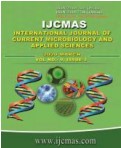


 National Academy of Agricultural Sciences (NAAS)
National Academy of Agricultural Sciences (NAAS)

|
PRINT ISSN : 2319-7692
Online ISSN : 2319-7706 Issues : 12 per year Publisher : Excellent Publishers Email : editorijcmas@gmail.com / submit@ijcmas.com Editor-in-chief: Dr.M.Prakash Index Copernicus ICV 2018: 95.39 NAAS RATING 2020: 5.38 |
Protected farming is becoming increasingly popular in different developed and developing countries of the world due to its multifaceted advantages. Study was carried out to evaluate the long term cultivation effect on soil health under poly houses of varying age groups. It was observed that after 3-5 years of cultivation, the soils under the poly houses were deteriorated due to formation of soil acidity, nutrient imbalance and reduction in microbial diversity and enzyme activity. Key soil enzymes, microbial biomass carbon and microbial population were assessed to understand the effect of poly house cultivation on soil health. pH, organic carbon content and bulk density of poly house soil of varying age groups varied significantly with respect to open field soil. Significantly lower cation exchange capacity and total exchangeable bases were recorded in poly house of >10 years age irrespective of soil depth and seasons. The available N, P2O5, K2O in soils showed an increasing trend up to 3-5 years of poly house age, thereafter decreased significantly. Irrespective of seasons and soil depth, the bacterial and fungal population showed a decreasing trend with advancement of poly house age. The microbial biomass carbon, dehydrogenase activity, phosphomonoesterase activity and Flourescent di acetate hydrolysis activity in soils showed a declining trend with increasing poly house age. Study indicated that the soils under poly houses required rejuvenation particularly after 6-8 years for improvement of physical, chemical and biological properties so as sustain soil health as well as crop productivity.
 |
 |
 |
 |
 |